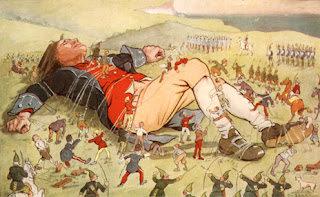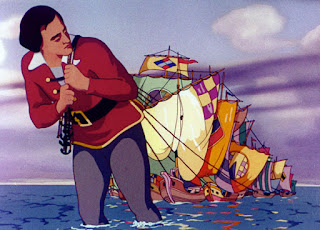Gulliver's Travels (by Jonathan Swift) is divided into four books:
In Book 1
the hero, ship’s surgeon Lemuel Gulliver, tells of his shipwreck off the island
of Lilliput. The Lilliputians, he discovers, are a
tiny people, only six inches high. During his stay on Lilliput he learns about
the local customs and culture, and about the country’s political system. He
offers to help the people in their war against another island, Blefuscu, after
which he returns to England.
In Book 2 Gulliver
sets off for India but after a series of misadventures finds himself abandoned
on the island of Brobdingnag whose inhabitants are all giants. The situation of
Book 1 is reversed, as Gulliver finds himself regarded as something like a living doll for children
to play with. He is sold to the Queen and has some interesting discussions with
the King about the political situation in Europe, before returning once again
to England.
Book 3 sees Gulliver land on the amazing flying
island of Laputa
with its capital Lagado which is populated by philosophers and scientists, all
involved in bizarre and ultimately futile scientific research and speculations.
From here
he Journeys to another two islands, Glubdubdrib and Luggnag, each with their own absurdities.
Book 4 finds Gulliver in a land ruled by intelligent
horses who call themselves the Houyhnhnms and who are served by a filthy,
bestial, subhuman race called the Yahoos. Again Gulliver spends his time trying to learn
the language and ways of the Houyhnhnms, and assimilates them so well that when
he returns home to his wife and children he finds himself disgusted by their
humanness.
Interpretation
Gulliver’s Travels has for a long time been considered a children’s classic
because of the wonderfully absurd imagination of its images and the simplicity
of its prose. But its dense mixture of fantasy, political satire and moral fable render it a highly complex work and
there has been much debate among literary critics in the centuries alter its
publication as to what Swift’s intentions in writing it actually were. Many
have regarded it as a misanthropic hook, a vicious attack on the human
race as a whole.
The hook’s
defenders, on the other hand, say that the book is a satire of man’s hypocrisy, vanity and
cruelty, his small-mindedness and absurd pretensions.
According
to this last scheme the four voyages might be read as follows:
First
Journey
The
diminutive Lilliputians, although a well-organised society, can be seen to
represent cruelty,
pettiness
and provincialism
(arguably the way Swift saw the England of his time). To their eyes Gulliver is
like a giant baby, a huge body controlled by its physical needs. Their only use
for him is as a weapon to destroy their enemies.
Second
Journey
The giants
of Brobdingnag represent human vanity and self-love. Gulliver’s descriptions
of their bodies (which to him are enormous) reveal a mixture of fascination
for, and disgust and repulsion towards the human body, which may be
seen as an obstacle to spiritual growth. But here the diminished Gulliver is
identified with the Lilliputians. This parallel is further emphasised by the
King’s response to Gulliver’s account of England, when he says that the
majority of the English appear to be ‘the most pernicious race of little odious
vermin that nature ever suffered to crawl upon the surface of the earth.’
Third
Journey
The
Laputans can be seen as a parody of the pretensions of abstract intellectual thinking,
which has no connection to reality (the island flies above the ground), and
also as a satire on Britain’s military and colonial ambitions (the king
threatens to land the island on any dissenting subjects, literally crushing
them to death).
Fourth
Journey
The land of
the Houyhnhnms where horses rule over a bestial subhuman race is one of the
best examples of Swiftian reversal. We are made to see Gulliver from the
perspective of the horses whose only experience of the human race is with the
savage Yahoos. Gulliver tries to convince them that his own race dry not at all
like the yahoos but from the horses’ point of view, the picture he portrays of
the violent and
vicious society he conies from merely confirms that underneath the
masquerade of civilisation, humans are indeed lost like the Yahoos – only more
sophisticated it their barbarism.
Source: Thomson
– Maglioni, Literary Links. Literature in time and space, Cideb, an old Italian
book 2000.




No comments:
Post a Comment